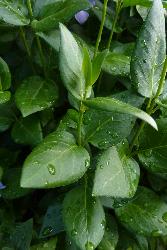- Taxon
- Weed
- Gallery
Stems glabrous, long and partly trailing or running and rooting at nodes, with terminal part often ascending, forming dense mats often covering many square metres. Petiole (5)–7–20 mm long; margins hirsute. Lamina (3)–4–10 × (1.8)–2.5–7 cm, ovate, usually dark glossy green above, rarely variegated white and green; midrib hairy above; margins ciliate; base mostly rounded or subcordate, sometimes truncate or broad-cuneate; apex obtuse or acute. Pedicels 2.5–4 cm long, slender. Calyx 0.9–1.7 cm long; lobes linear-subulate, ciliate, glandular towards base. Corolla tube c. 1.5 cm long; limb (3)–3.5–5 cm diam., mauvish blue; lobes obliquely obovate; apex truncate or obtuse. Anthers slightly wider than long. Follicles 3.5–5 cm long, the apical part very narrow and pointed, constricted between seeds. Seeds 7–8 mm long, oblong, strongly corrugated; margins inrolled.
[From: Webb et al. (1988) Flora of New Zealand. Volume 4.]
Flowering: Jan.–Dec.




